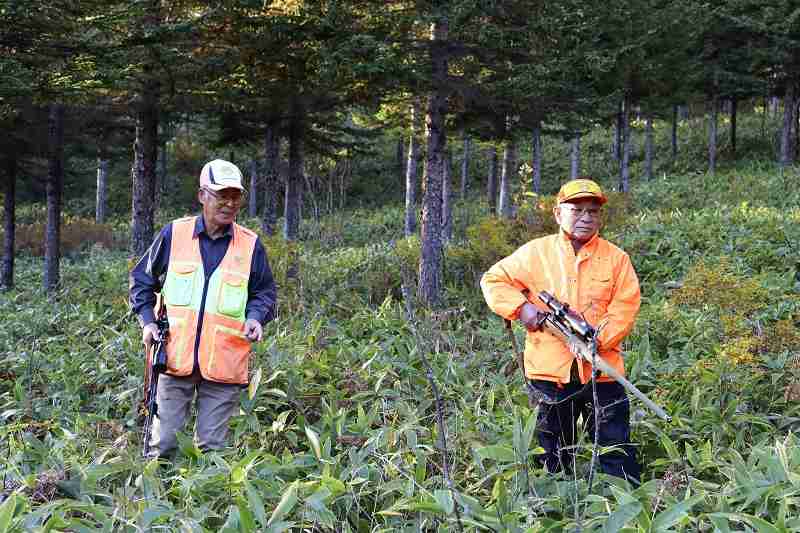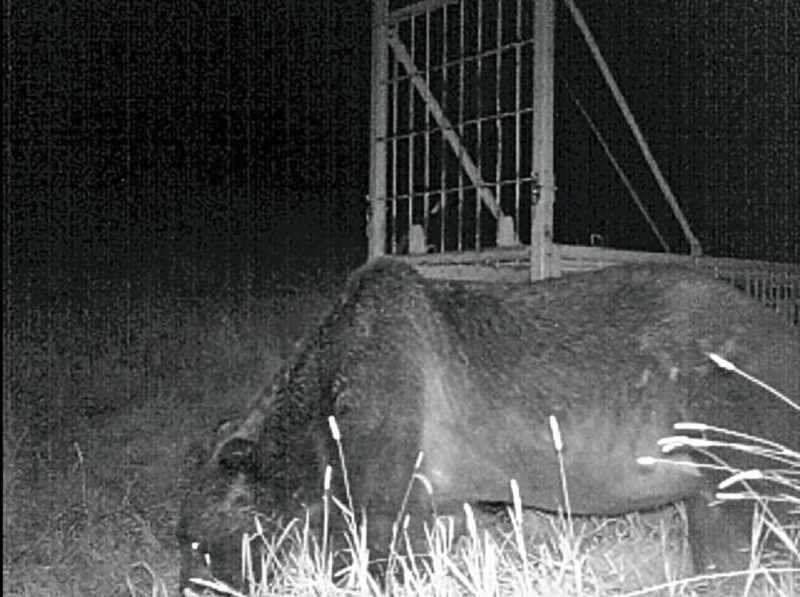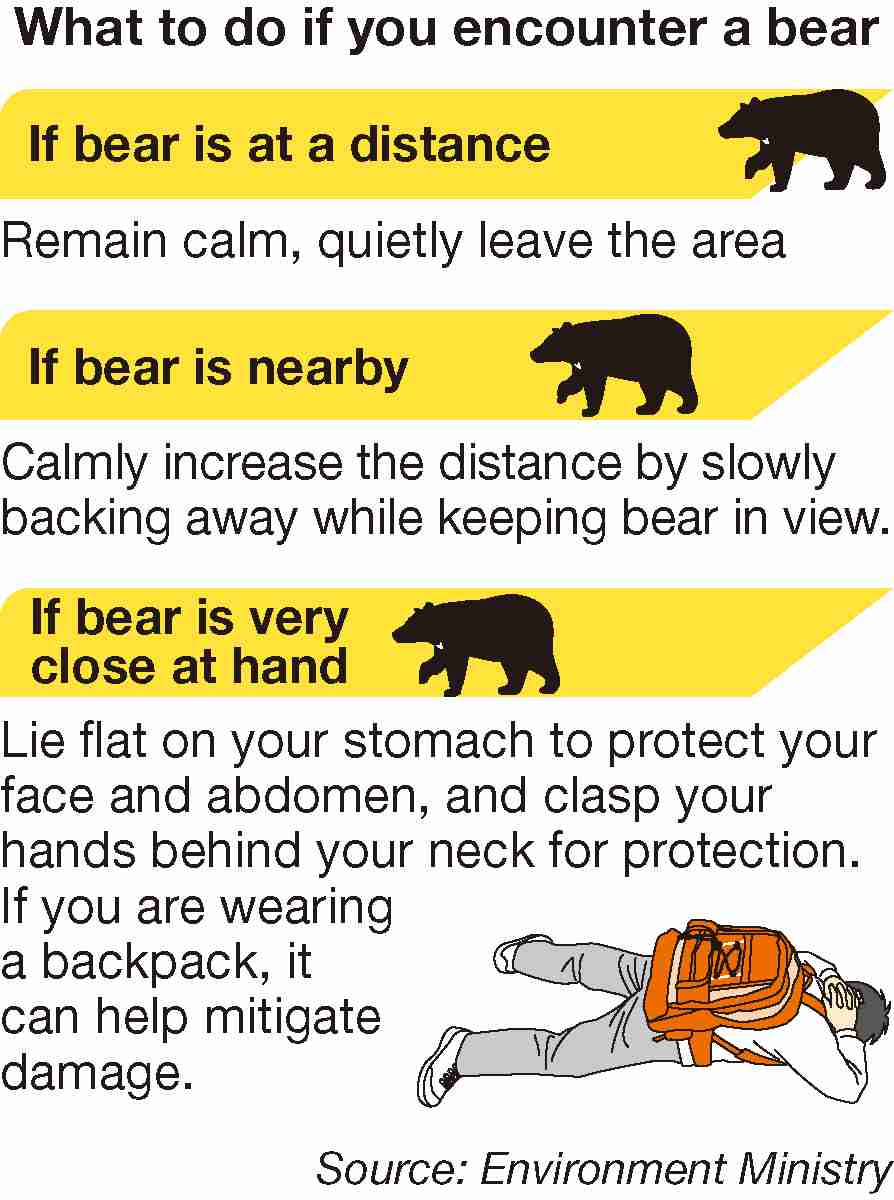
Isao Goto, left, and another hunter search for clues of Oso 18 in the mountains of Shibecha, Hokkaido, on Oct. 17.
7:00 JST, November 12, 2022
SHIBECHA/AKKESHI, Hokkaido — Since 2019, one large brown bear has attacked and killed grazing dairy cattle in the towns of Shibecha and Akkeshi in eastern Hokkaido. The bear, called Oso 18, has injured a total of 65 dairy cows, including eight this year, and killed 31 of them.
By evading traps and hunting for prey under the cover of night, Oso 18 is posing a serious threat to areas where dairy farming is an important industry.
One day in mid-October, Isao Goto, 79, head of the Shibecha branch of the Hokkaido Hunting Public Service Corporation, a local hunters association, urged other hunters to keep their senses sharp as they drove into the Shibecha mountains to follow traces of Oso 18.
The attacks on cattle believed to be done by the bear began in the Osotsubetsu district of Shibecha in July 2019, when a free-range cow was found with its back torn apart. Analysis of footprints estimated that a male bear over 10 years old, about 2 meters in length and weighing more than 300 kilograms, was behind the attack. Since its footprints were as large as 18 centimeters in width and found in the Osotsubetsu district, the bear earned the name Oso 18.
This year, the bear’s attacks began in July, but stopped on Aug. 20. Since Oso 18 is cautious and can be found at various places, Goto and other hunters spent about four hours scouring the mountains with rifles , but could not find the animal.
Brown bears are larger than Asiatic black bears found in Honshu and the Shikoku region, but usually feed on nuts. They sometimes prey on Yezo sika deer and seldom attack cattle.

Footage from a security camera shows a brown bear believed to be Oso 18 passing by a trap filled with bait.
Highly cautious bear
Oso 18 is thought to be highly intelligent and has learned how to evade hunters. The bear only focuses on cows grazing from midnight to dawn, staying away from barns as well as other houses or buildings.
It is believed to move through streams or forests, leaving few footprints. Unlike other brown bears, Oso 18 does not have the habit of burying its catch in the soil and returning to the place later. Although it has attacked cattle in areas stretching more than 30 kilometers in a straight line, there has been only one reported sighting of what appears to be the bear.
Footage from a security camera shows the bear walking past a bait-laden trap placed by town officials in Shibecha. “The bear is highly cautious, and acts like it can read people’s minds,” said a vexed Takumi Miyazawa, chief of the town’s agriculture and forestry division.
Ranches are taking measures to cope with the situation. In spring, the Akkeshi municipal ranch installed electric fences around an area with a circumference of 23 kilometers that includes the place where four dairy cows were attacked last year. It covers only about ¼ of the farm’s total area, but the ranch’s manager, Tadahiro Sakurai, 57, said they have no choice but to take all possible measures.
According to the DNA analysis of hair and other samples collected at the site where cows were attacked, no brown bears other than Oso 18 appear to be attacking cattle. The Hokkaido prefectural brown bear control office believes there would be no more damage if Oso 18 was eliminated.The office believes it is appropriate to get rid of the animal since the local dairy industry has been affected as they are unable to put cattle out to pasture, for instance.
Locals harbor a stronger sense of crisis. “I want to get rid of the bear before it goes into hibernation this winter, otherwise second or third Oso 18 might emerge” Goto said.
¥250 million in agricultural damage
In Hokkaido, brown bears used to be eliminated in spring after their hibernation. But the practice was done away with in 1990 in the face of growing sentiment that a symbol of majestic nature should be protected.
The population of brown bears has recovered since then. According to the prefecture, there was an estimated 6,600 to 19,300 brown bears in 2020, up from 3,800 to 7,000 in 1990.
However, this has led to an increase in the number of cases where brown bears have come near human dwellings. In fiscal 2021, a record 14 people died or were injured after brown bear attacks. Four of them sustained minor or serious injuries in Sapporo’s urban districts.
The damage to agriculture has also worsened, with ¥249 million reported in fiscal 2020, an increase of about 50% over the past 10 years.

How to Protect Yourself During Bear Encounters
Related Tags
"Society" POPULAR ARTICLE
-

M4.9 Earthquake Hits Tokyo, Neighboring Prefectures
-

Israeli Tourists Refused Accommodation at Hotel in Japan’s Nagano Pref., Prompting Protest by Israeli Embassy and Probe by Prefecture
-

M7.5 Earthquake Hits Northern Japan; Tsunami Waves Observed in Hokkaido, Aomori and Iwate Prefectures
-

Tsukiji Market Urges Tourists to Avoid Visiting in Year-End
-

High School in Kyoto Says Students Shoplifted during Recent School Trip to Bali, Indonesia
JN ACCESS RANKING
-

Tokyo Economic Security Forum to Hold Inaugural Meeting Amid Tense Global Environment
-

Keidanren Chairman Yoshinobu Tsutsui Visits Kashiwazaki-Kariwa Nuclear Power Plant; Inspects New Emergency Safety System
-

Imports of Rare Earths from China Facing Delays, May Be Caused by Deterioration of Japan-China Relations
-

University of Tokyo Professor Discusses Japanese Economic Security in Interview Ahead of Forum
-

Japan Pulls out of Vietnam Nuclear Project, Complicating Hanoi’s Power Plans























